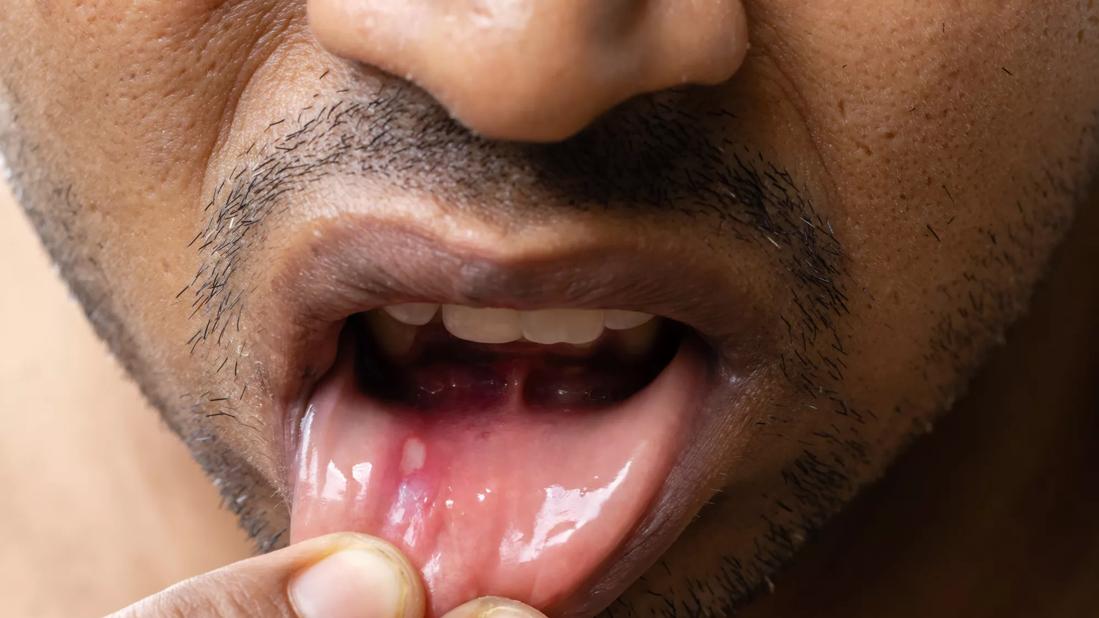Non-cancerous ulcers usually heal within a few days or weeks — if it’s sticking around, it’s time to get it checked

Most of the time, that obnoxious little sore in your mouth is a canker sore. Unlike cold sores, canker sores aren’t contagious — just uncomfortable. And they’re extremely common: Approximately 20% of the U.S. population has had at least one canker sore in their lifetime. Anyone can get them, and while they can sometimes be a sign of an underlying medical condition, they’re usually nothing to worry about. They resolve on their own and you move on with your life.
Advertisement
Cleveland Clinic is a non-profit academic medical center. Advertising on our site helps support our mission. We do not endorse non-Cleveland Clinic products or services. Policy
But not all mouth ulcers are canker sores. Sometimes, these conditions require medical intervention. Even oral cancers can seem pretty similar to the common canker sore. At least, they seem similar if you don’t know what you’re looking (and feeling) for.
Enter ear, nose and throat specialist (otolaryngologist) Ashley Mays, MD. With her help, we walk through the differences between canker sores, oral cancers and other mouth ulcers.
So, how can you tell if you have a canker sore? Let’s start with what you’ll see when you look in a mirror. According to Dr. Mays, the key characteristics to pay attention to are:
Advertisement
Of course, a canker sore is more than just something you see. You feel them, too! Dr. Mays explains that the symptoms they cause are pretty consistent.
“While there are exceptions, canker sores typically hurt,” she says. The pain tends to be of the burning and tingling variety. And if you’ve ever tried to down a glass of orange juice while you’ve got one, you know all too well that they’re extra ouchy when they’re irritated.
“It’s best to avoid spicy or acidic food and drink when you have a canker sore,” Dr. Mays advises. “You may find that hard or sharp foods — like potato chips or crusty bread — also bother you.”
Depending on where the ulcer is in your mouth, you may find eating, drinking, brushing your teeth or talking uncomfortable. Uncomfortable, but not undoable. A canker sore can be seriously annoying, but it shouldn’t be debilitating.
Now that you have a good idea of what a canker sore looks and feels like, let’s talk about mouth ulcers or lesions that are more suspicious.
There are lots of different kinds of mouth ulcers and they aren’t always cause for concern. (That’s right: Not all roads lead to oral cancer!) But you still need to see a doctor or dentist. They’ll determine what exactly is going on and prescribe a course of treatment.
Here are some of the physical characteristics to be on the lookout for:
That’s what you might be seeing. But some oral cancers and abnormal ulcers aren’t that obvious to us. That’s in part because they can hide behind your teeth or under your tongue. And keep in mind that — unlike canker sores — other kinds of mouth ulcers and oral cancer can appear on your outer lips.
Dr. Mays recommends paying close attention to other symptoms, like:
Advertisement
Some of these symptoms really hit you over the head. But others can easily slip under the radar — especially if they aren’t preventing us from living our busy lives.
“We see patients all the time who had an irritation around their tooth that ends up being squamous cell cancer, which may have been bothering them for up to a year,” Dr. Mays shares.
“That’s why it’s important to notice when your symptoms don’t resolve. If they last for more than two weeks, get them checked out by a doctor or dentist.”
Your dentist performs an oral cancer screening every time you go in for a cleaning, which should be twice a year.
According to Dr. Mays, the oral cancer screening process takes less than 10 minutes. Your doctor or dentist will perform a visual assessment and feel your tongue looking for abnormal color and firm lesions. You also fill out an information form so the provider can pay close attention to any specific areas of concern. If you’re keeping those appointments — and feel comfortable that your mouth ulcer is a canker sore — there’s little reason to follow up.
If your symptoms aren’t resolving, or are getting worse, that’s another story. Then, it’s time to call a provider.
Ideally, you want to get an appointment with an ear, nose and throat (ENT) specialist like Dr. Mays. If you don’t already work with an ENT, make an appointment with your primary care provider. They can refer you if their attempts to diagnose or treat your mouth sore aren’t effective.
Advertisement
Here are a few other reasons to consider making an appointment with a provider:
Taking the time to be extra cautious can really pay off — especially if that sore in your mouth is cancerous.
“Nobody wants a cancer diagnosis. But the good news is that, when picked up early, oral cancers are highly curable,” encourages Dr. Mays. “Early detection is key. So, if you have symptoms, don’t ignore them.”
Advertisement
Learn more about our editorial process.
Advertisement

These common mouth sores are very different — cold sores are caused by a virus and are contagious, but canker sores aren’t

This medicated liquid is available by prescription only and is specially formulated for your specific needs

Lots of things can activate the herpes simplex virus, from the common cold and cold weather to cracked skin and cosmetic procedures

This oral health practice doesn’t have proven benefits, and it’s not a substitute for brushing and flossing

Prescription oral antivirals are your best bet, but OTC creams can help, too

Stay hydrated, use a humidifier and try sugar-free candies or over-the-counter products with xylitol

Get quick relief with ice chips, popsicles, milk and saltwater

Chronic and extreme bad breath could signal a health issue that needs attention

The best parenting style balances enforcing rules and showing plenty of love

Tips include cutting back on sugar, focusing on exercise and managing stress

It can be harder to let go when you’ve invested time, energy and emotions — but it might be the healthier choice long term